A Fast Method for Calculation of Marine Gravity Anomaly
Abstract
1. Introduction
2. Method
2.1. The Inverse Stokes Formula
2.2. The Proposed Fast Method
- (1)
- Initialize MATLAB.
- (2)
- Input the gridded data of global geoid height undulation and the corresponding parameters dla (the grid interval along the latitude direction) and dlo (the grid interval along the longitude direction). Transform the gridded data into the vector global_N, and set the corresponding vectors global_la (the latitude coordinate vector of global geoid height undulation) and global_lo (the longitude coordinate vector of global geoid height undulation).
- (3)
- Input the gridded data of geoid height undulation of the study area. Extract the data in the sea from the gridded data, transform the data in the sea into the vector study_N, and compute the number of elements in the vector study_N (study_number). Set the corresponding vectors study_la (the latitude coordinate vector of geoid height undulation of the study area) and study_lo (the longitude coordinate vector of geoid height undulation of the study area). Compute the index vector pos, which represents the location (index) of the elements of the vector study_N in the vector global_N.
- (4)
- Set the average_G (the average gravity of the Earth) and R (the average radius of the Earth). Then, use the code as shown in Figure 2 to compute the vector study_Grav (the marine gravity anomaly of the study area).
- (5)
- Transform the vector study_Grav into gridded data.
- (6)
- Output the results.
3. Results
3.1. Precision and Accuracy Test
3.2. Efficiency Test
4. Conclusions
Author Contributions
Funding
Acknowledgments
Conflicts of Interest
Appendix A
References
- Li, Y.; Guo, Q.; Huang, M.; Ma, X.; Chen, Z.; Liu, H.; Sun, L. Study of an Electromagnetic Ocean Wave Energy Harvester Driven by an Efficient Swing Body Toward the Self-Powered Ocean Buoy Application. IEEE Access 2019, 7, 129758–129769. [Google Scholar] [CrossRef]
- Li, W.; Chen, G.; Kong, Q.; Wang, Z.; Qian, C. A VR-Ocean system for interactive geospatial analysis and 4D visualization of the marine environment around Antarctica. Comput. Geosci. 2011, 37, 1743–1751. [Google Scholar] [CrossRef]
- Mohanty, K.; Majumdar, T. Altimeter-plot: A C-language program for simultaneous plotting of satellite altimeter-derived geophysical parameters. Comput. Geosci. 1994, 20, 839–848. [Google Scholar] [CrossRef]
- Andersen, O.B.; Knudsen, P. Global marine gravity field from the ERS-1 and Geosat geodetic mission altimetry. J. Geophys. Res. Ocean. 1998, 103, 8129–8137. [Google Scholar] [CrossRef]
- Wan, X.; Ran, J. An alternative method to improve gravity field models by incorporating GOCE gradient data. Earth Sci. Res. J. 2018, 22, 187–193. [Google Scholar] [CrossRef]
- Wan, X.; Ran, J.; Jin, S. Sensitivity analysis of gravity anomalies and vertical gravity gradient data for bathymetry inversion. Mar. Geophys. Res. 2018, 40, 87–96. [Google Scholar] [CrossRef]
- Yang, Y.; Hwang, C.; Hsu, H.-J.; Dongchen, E.; Wang, H. A subwaveform threshold retracked for ERS-1 altimetry: A case study in the Antarctic Ocean. Comput. Geosci. 2012, 41, 88–98. [Google Scholar] [CrossRef]
- Niedzielski, T.; Miziński, B. Automated system for near-real time modelling and prediction of altimeter-derived sea level anomalies. Comput. Geosci. 2013, 58, 29–39. [Google Scholar] [CrossRef]
- Hofmann-Wellenhof, B.; Moritz, H. Physical Geodesy, 2nd ed.; Springer Vienna Publisher: Vienna, Austria, 2006. [Google Scholar]
- Zhu, C.; Guo, J.; Hwang, C.; Gao, J.; Yuan, J.; Liu, X. How HY-2A/GM altimeter performs in marine gravity derivation: Assessment in the South China Sea. Geophys. J. Int. 2019, 219, 1056–1064. [Google Scholar] [CrossRef]
- Balmino, G.; Moynot, B.; Sarrailh, M.; Valès, N. Free air gravity anomalies over the oceans from Seasat and GEOS 3 altimeter data. Eos Trans. Am. Geophys. Union 1987, 68, 17–19. [Google Scholar] [CrossRef]
- Wan, X.; Yu, J. Accuracy analysis of thee remove-restore process in inverse stokes formula. Wuhan Daxue Xuabao 2012, 37, 77–80. (In Chinese) [Google Scholar]
- Zhang, C.; Blais, J.A.R. Comparison of methods for marine gravity determination from satellite altimetry data in the Labrador Sea. Bull. Géodésique 1995, 69, 173–180. [Google Scholar] [CrossRef]
- Hwang, C. Inverse Vening Meinesz formula and deflection-geoid formula: Applications to the predictions of gravity and geoid over the South China Sea. J. Geod. 1998, 72, 304–312. [Google Scholar] [CrossRef]
- Wan, X.; Jin, S.; Liu, B.; Tian, S.; Kong, W.; Annan, R.F. Effects of Interferometric Radar Altimeter Errors on Marine Gravity Field Inversion. Sensors 2020, 20, 2465. [Google Scholar] [CrossRef]
- Olgiati, A.; Balmino, G.; Sarrailh, M.; Green, C.M. Gravity anomalies from satellite altimetry: Comparison between computation via geoid heights and via deflections of the vertical. Bull. Géodésique 1995, 69, 252–260. [Google Scholar] [CrossRef]
- Zhang, C.; Sideris, M.G. Oceanic gravity by analytical inversion of Hotine’s formula. Mar. Geod. 1996, 19, 115–136. [Google Scholar] [CrossRef]
- Andersen, O.B.; Knudsen, P.; Berry, P.A.M. The DNSC08GRA global marine gravity field from double retracked satellite altimetry. J. Geod. 2010, 84, 191–199. [Google Scholar] [CrossRef]
- Chen, Z.; Meng, X.; Guo, L.; Liu, G. GICUDA: A parallel program for 3D correlation imaging of large scale gravity and gravity gradiometry data on graphics processing units with CUDA. Comput. Geosci. 2012, 46, 119–128. [Google Scholar] [CrossRef]
- Zhang, S.; Meng, X.; Chen, Z.; Zhou, J. Rapid calculation of gravity anomalies based on residual node densities and its GPU implementation. Comput. Geosci. 2015, 83, 139–145. [Google Scholar]
- Chen, Z.; Meng, X.; Zhang, S. 3D gravity interface inversion constrained by a few points and its GPU acceleration. Comput. Geosci. 2015, 84, 20–28. [Google Scholar] [CrossRef]
- Liu, G.; Li, C. Practical Implementation of Prestack Kirchhoff Time Migration on a General Purpose Graphics Processing Unit. Acta Geophys. 2016, 64, 1051–1063. [Google Scholar] [CrossRef][Green Version]
- Wang, J.; Meng, X.; Li, F. A computationally efficient scheme for the inversion of large scale potential field data: Application to synthetic and real data. Comput. Geosci. 2015, 85, 102–111. [Google Scholar] [CrossRef]
- Chen, T.; Zhang, G. Forward modeling of gravity anomalies based on cell mergence and parallel computing. Comput. Geosci. 2018, 120, 1–9. [Google Scholar] [CrossRef]
- Suh, J.W.; Kim, Y. Accelerating MATLAB with GPU Computing: A Primer with Examples; Morgan Kaufmann Publisher Inc.: Burlington, MA, USA, 2014. [Google Scholar]
- Moorkamp, M.; Jegen, M.; Roberts, A.; Hobbs, R. Massively parallel forward modeling of scalar and tensor gravimetry data. Comput. Geosci. 2010, 36, 680–686. [Google Scholar] [CrossRef]
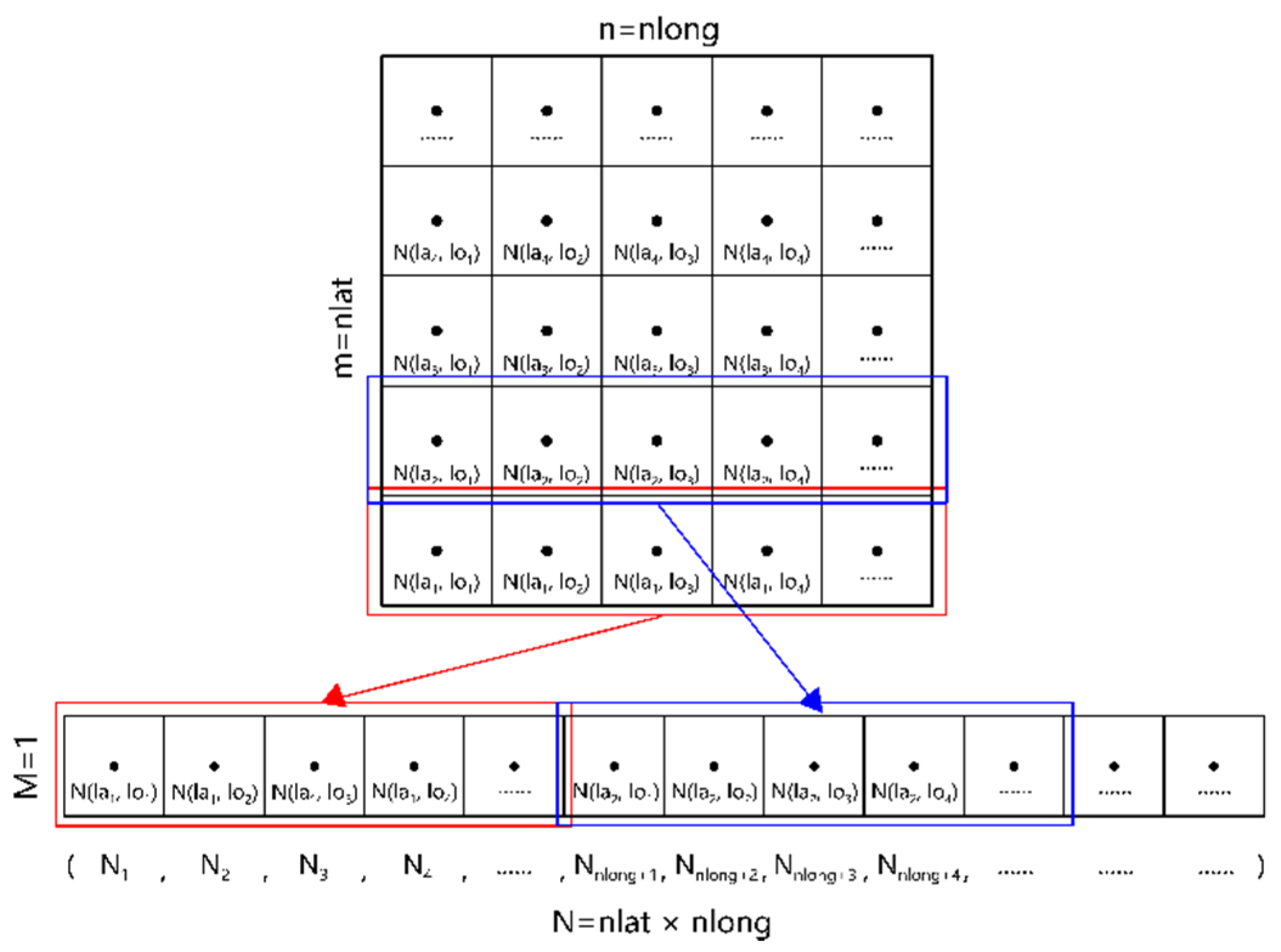
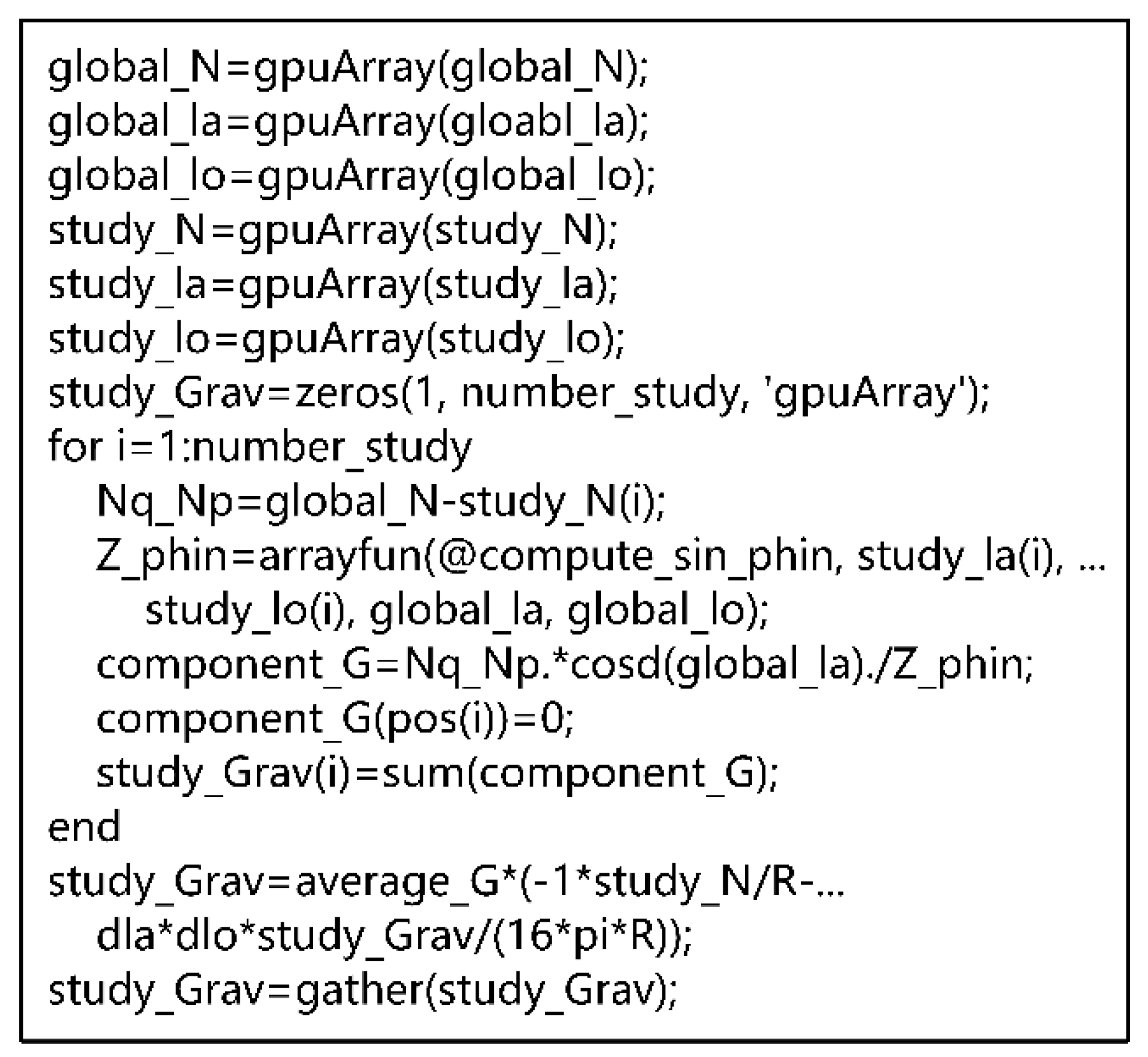
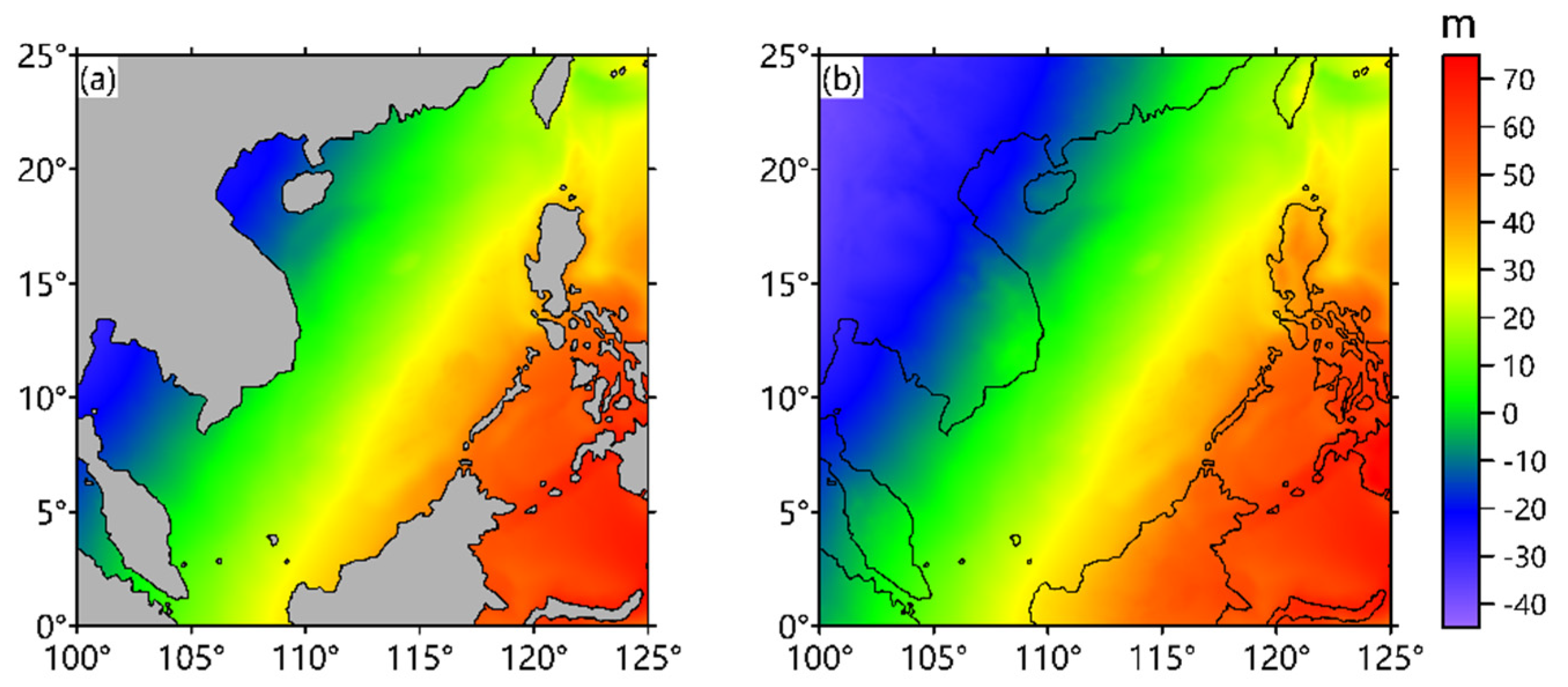
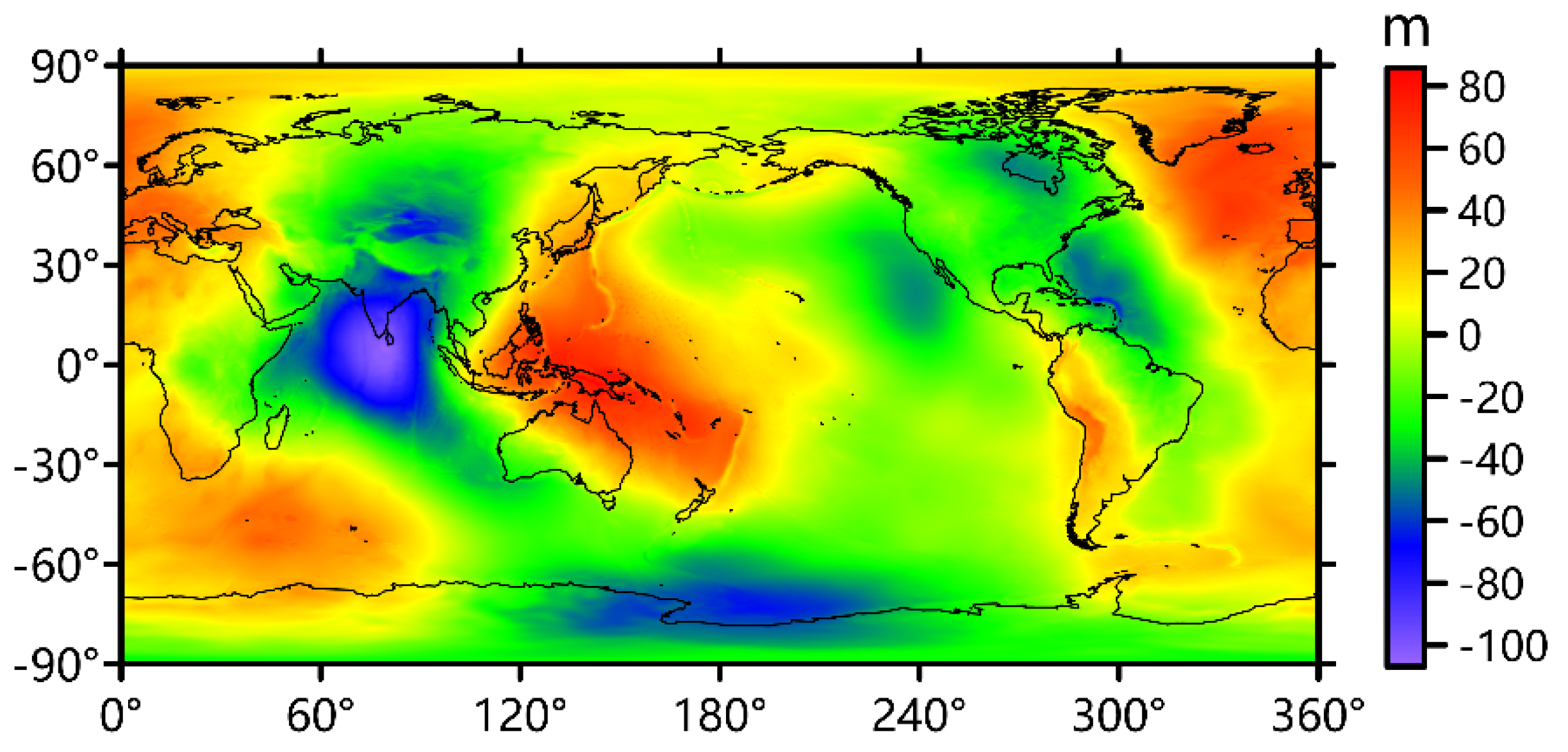
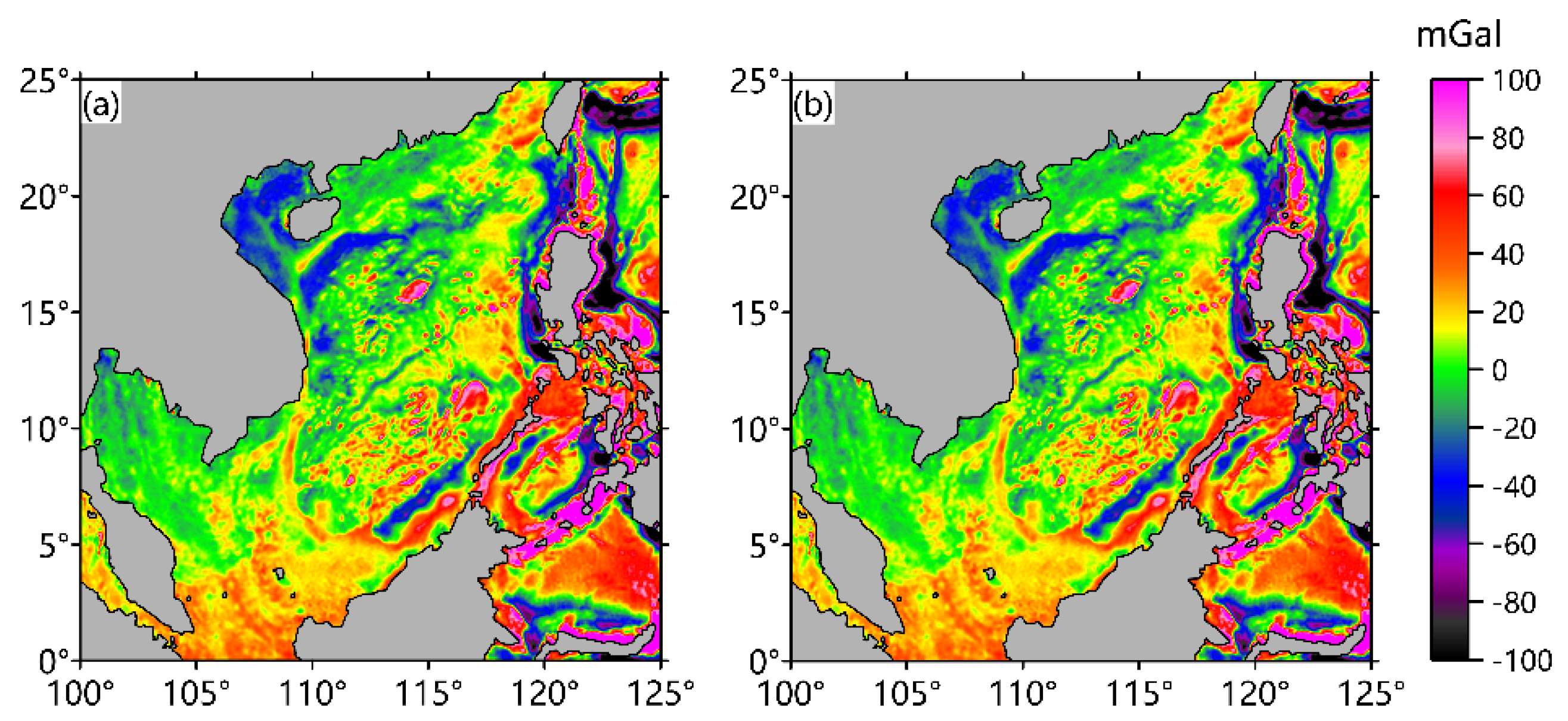
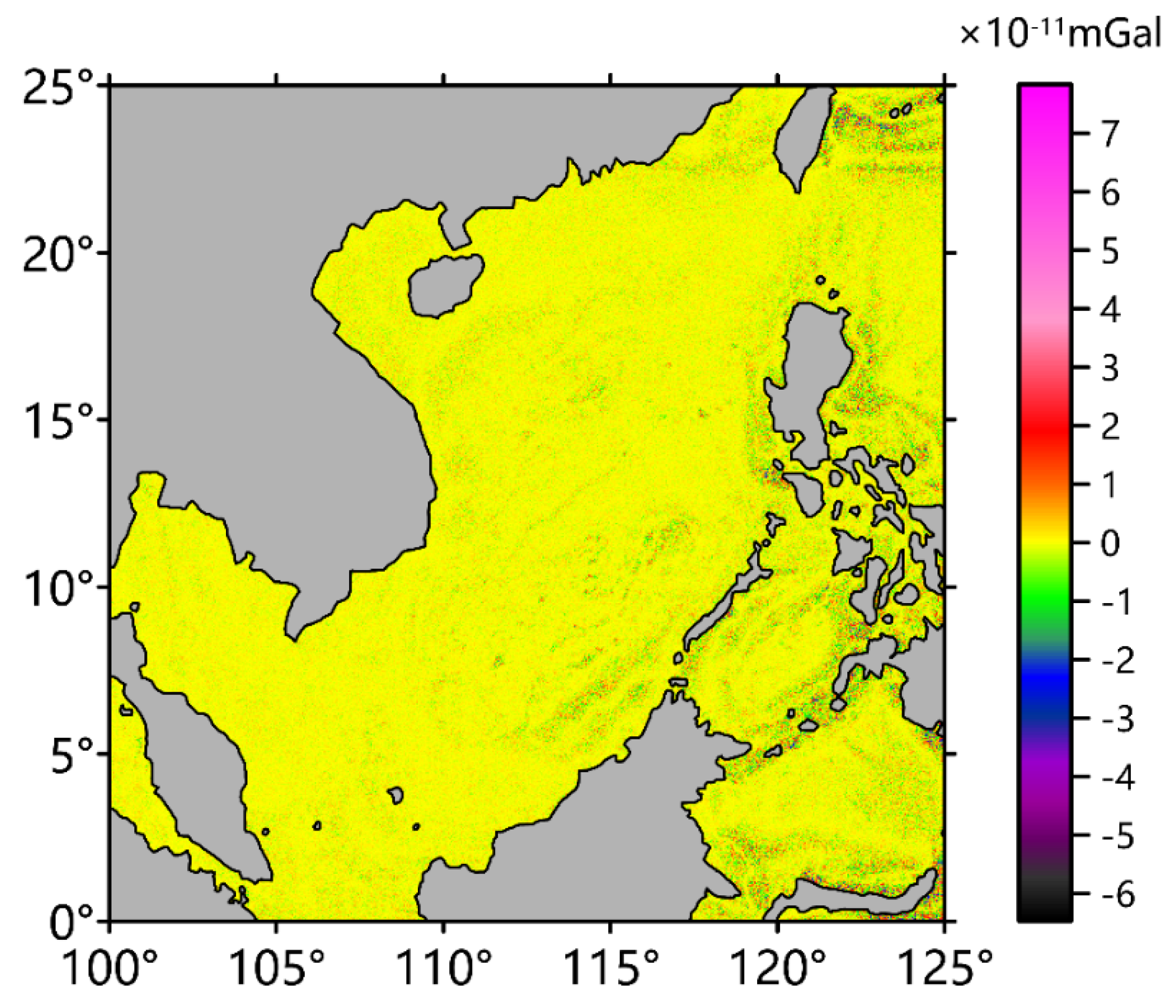
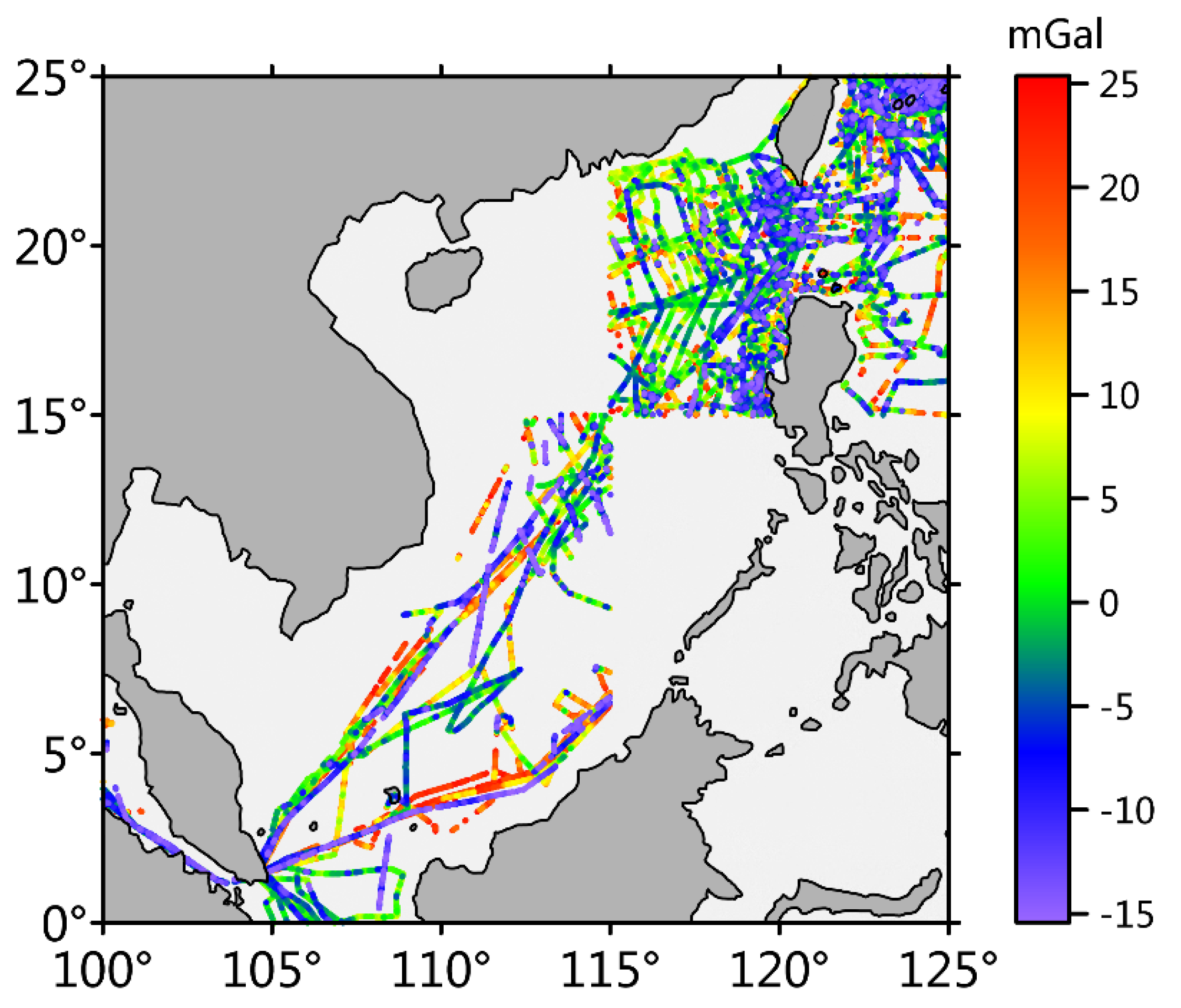
| Minimum | Maximum | Mean | Standard Deviation |
|---|---|---|---|
| −15.422 mGal | 25.376 mGal | 3.990 mGal | 9.753 mGal |
| Test No. | Grid Size of the Global Geoid Height Undulation | Grid Intervals of the Global Geoid Height Undulation | Grid Size of Geoid Height Undulation of the Study Area | Grid Intervals of Geoid Height Undulation of the Study Area |
|---|---|---|---|---|
| 1 | 360 × 180 | 1° × 1° | 25 × 25 | 1° × 1° |
| 2 | 720 × 360 | 0.5° × 0.5° | 50 × 50 | 0.5° × 0.5° |
| 3 | 1440 × 720 | 0.25° × 0.25° | 100 × 100 | 0.25° × 0.25° |
| 4 | 2880 × 1440 | 0.125° × 0.125° | 200 × 200 | 0.125° × 0.125° |
| 5 | 5760 × 2880 | 0.0625° × 0.0625° | 400 × 400 | 0.0625° × 0.0625° |
| Test No. | Classical Method with 1 CPU Core | Classical Method with 4 CPU Cores | Proposed Fast Method | Speedup Ratio 1 | Speedup Ratio 2 |
|---|---|---|---|---|---|
| 1 | 9.237906 s | 33.911662 s | 1.109683 s | 8.324815 | 30.559774 |
| 2 | 142.453723 s | 71.577470 s | 7.812566 s | 18.233923 | 9.161839 |
| 3 | 2287.076139 s | 666.717880 s | 79.818624 s | 28.653415 | 8.352911 |
| 4 | 37913.763020 s | 10057.006520 s | 1099.028247 s | 34.497533 | 9.150817 |
| 5 | 682715.142000 s | 185659.916600 s | 16843.824590 s | 40.532074 | 11.022432 |
Publisher’s Note: MDPI stays neutral with regard to jurisdictional claims in published maps and institutional affiliations. |
© 2021 by the authors. Licensee MDPI, Basel, Switzerland. This article is an open access article distributed under the terms and conditions of the Creative Commons Attribution (CC BY) license (http://creativecommons.org/licenses/by/4.0/).
Share and Cite
Fang, Y.; He, S.; Meng, X.; Wang, J.; Gan, Y.; Tang, H. A Fast Method for Calculation of Marine Gravity Anomaly. Appl. Sci. 2021, 11, 1265. https://doi.org/10.3390/app11031265
Fang Y, He S, Meng X, Wang J, Gan Y, Tang H. A Fast Method for Calculation of Marine Gravity Anomaly. Applied Sciences. 2021; 11(3):1265. https://doi.org/10.3390/app11031265
Chicago/Turabian StyleFang, Yuan, Shuiyuan He, Xiaohong Meng, Jun Wang, Yongkang Gan, and Hanhan Tang. 2021. "A Fast Method for Calculation of Marine Gravity Anomaly" Applied Sciences 11, no. 3: 1265. https://doi.org/10.3390/app11031265
APA StyleFang, Y., He, S., Meng, X., Wang, J., Gan, Y., & Tang, H. (2021). A Fast Method for Calculation of Marine Gravity Anomaly. Applied Sciences, 11(3), 1265. https://doi.org/10.3390/app11031265





